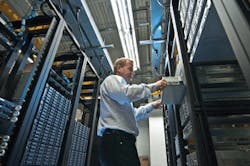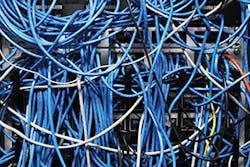Data Center Functionality Transforms the Central Office —
The central office (CO) is poised for great change in coming years based on current trends in technology. Video is projected to be 82% of all IP traffic by the year 2020 according to Cisco’s Visual Networking Index.
The Internet of Things increasingly enables everyday objects to send and receive data, and the competitive landscape continues to shift as companies find new ways to respond to evolving demands. Connectivity, usage, and service, are just a few areas where providers are having to deliver in new ways in order to keep up.
IHS completed a study in 2017 that found 30% of the CO owners polled were planning to implement some fashion of CORD within the year — ahead of prior market predictions.
For this reason, a standardized platform that can combine all applications through single functionality is becoming a necessary answer, though it is a preference, too. Driven by a desire to deliver real-time service responses to residential and business subscribers, operators are increasingly transforming their traditionally run COs to data center functionality instead.
The idea behind the edge data center is to move the data center computing and storage functions closer to consumers in order to save on network charges. When this idea is simulated in the CO, it enables seamless multiple jumps across technology. Utilizing all of the purpose-built equipment of data center functionality not only cuts costs, but also allows network scalability and faster service delivery.
As technology continues to change, it is clear that one thing is not changing: the demand for high bandwidth and reliable connectivity — and therefore a better service model with which to deliver it.
Structured cabling solutions put the "manage" in central office management.
These demands can be met by capitalizing on them: as response to demands increases, so do IP networks within COs. Leveraging the trends of Network Function Virtualization (NFV) and Software Defined Networks (SDN) clears the way for equipment virtualization on a standard server where the function itself can be defined by the software. This move creates a more agile and adaptable network, and lowers capital and operational expenditures, due to the streamlined, real-time service and standardized infrastructure.
The Central Office Rearchitecture as a Data Center, or CORD, is a multi-part process with an impact on the entire network. Bringing data center functionality to the CO involves a combination of old and new; there is a mix of traditional CO equipment, along with less familiar data center equipment such as Ethernet switches and servers. In addition to the mix of equipment, the CO re-architecture also includes a combination of single-mode and multimode connections. In order for CORD to work efficiently, both have to co-exist side-by-side in the same facility.
Another example showing how structured cabling solutions put the "manage" in central office management.
With CORD, single-mode fiber continues to serve the transport side of the network outside of the CO, where its value carrying information over long distances comes into play. Once you get inside the CO, multimode fiber is used on the processing side over standard servers and Ethernet switches. As more Ethernet technology enters the CO, the number of multimode connections grows.
Among this mixing of old and new comes the need for a structured cabling solution that can achieve greater density than the traditionally operated CO, while enabling moves, adds, and changes — without service disruptions.
Structured cabling also saves ample space in the pathways running to and from the CO. With the use of high-fiber-count trunks, which combine the same amount of bandwidth, but take up one-third the space of individually jacketed fibers, structured cabling becomes a flexible asset that allows migration through different changes in technology without having to re-pull cable.
The improved scalability for growth is among the key reasons that network operators have conducted CORD trials in their own COs over the past several years and are now implementing it globally. IHS completed a study in 2017 that found 30% of the CO owners polled were planning to implement some fashion of CORD within the year — ahead of prior market predictions. You can imagine that trend will only continue. It is clear that the advantages of CORD or a virtualized CO are attractive to both operators and service providers.
Small-form-factor connectors enable usable density gains in the central office.
In summary, customer demand is continuously driving change within the market. A transformation at the heart of operations is necessary to react to the increase in demand and meet consumer expectations by improving how the services arrive to the home or business. This requirement calls for not only a higher data and bandwidth model, but also a better service model with which to deliver it.
The shift to data center functionality into the CO will meet these customer demands and adapt to market changes. By structuring the CO with a mix of single-mode and multimode connections, shifting to data center functionality can also provide revenue opportunities for providers with the ability to offer hosting or content delivery services. A standardized platform that will enable jumps in technology that are on the horizon is the necessary step toward future satisfaction — both for home and business consumers, and for the service provider.
About the Authors
Brian K. Davis is Market Development Manager for Global Inside Plant, Corning Optical Communications. He has more than 25 years of experience in telecommunications, focusing today on helping network operators prepare their inside plant for emerging services and applications. Brian is married and has 3 children, holds 4 US patents, and has 1 hole-in-one.
For more information, please email [email protected] or visit www.corning.com/opcomm. Follow
Corning Optical Communications on Twitter: @CorningOpComm.
About the Author




